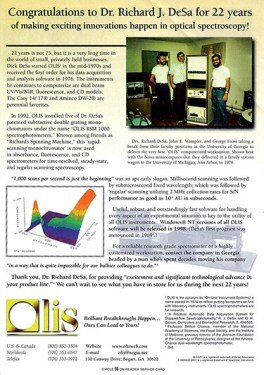The smart Trick of Uv/vis That Nobody is Talking About
The smart Trick of Uv/vis That Nobody is Talking About
Blog Article
Some Known Incorrect Statements About Circular Dichroism
Table of ContentsWhat Does Circularly Polarized Luminescence Do?An Unbiased View of SpectrophotometersUv/vis for BeginnersThe smart Trick of Circular Dichroism That Nobody is Talking AboutAn Unbiased View of Spectrophotometers

Spectrophotometry is a tool that hinges on the quantitative analysis of molecules depending on how much light is taken in by colored substances.
5 Easy Facts About Spectrophotometers Explained
A spectrophotometer is commonly utilized for the measurement of transmittance or reflectance of solutions, transparent or opaque solids, such as refined glass, or gases. Lots of biochemicals are colored, as in, they soak up noticeable light and therefore can be measured by colorimetric treatments, even colorless biochemicals can typically be transformed to colored substances appropriate for chromogenic color-forming reactions to yield substances suitable for colorimetric analysis.: 65 However, they can likewise be created to measure the diffusivity on any of the noted light ranges that usually cover around 2002500 nm using different controls and calibrations.
An example of an experiment in which spectrophotometry is utilized is the determination of the equilibrium constant of a solution. A specific chemical response within an option may take place in a forward and reverse direction, where reactants form products and items break down into reactants. At some point, this chain reaction will reach a point of balance called an equilibrium point.
Circularly Polarized Luminescence Things To Know Before You Buy
The amount of light that goes through the solution is a sign of the concentration of particular chemicals that do not allow light to go through. The absorption of light is because of the interaction of light with the electronic and vibrational modes of particles. Each kind of molecule has an individual set of energy levels related to the makeup of its chemical bonds and nuclei and thus will absorb light of specific wavelengths, or energies, leading to distinct spectral residential or commercial properties.
They are widely utilized in many industries including semiconductors, laser and optical production, printing and forensic assessment, as well as in laboratories for the research study of chemical substances. Spectrophotometry is typically utilized in measurements of enzyme activities, decisions of protein concentrations, decisions of enzymatic kinetic constants, and measurements of ligand binding reactions.: 65 Ultimately, a spectrophotometer is able to figure out, depending on the control or calibration, what compounds are present in a target and exactly how much through estimations of observed wavelengths.
Created by Arnold O. Beckman in 1940 [], the spectrophotometer was produced with the aid of his colleagues at his company National Technical Laboratories established in 1935 which would end up being Beckman Instrument Company and eventually Beckman Coulter. This would come as an option to the formerly created spectrophotometers which were unable to take in the ultraviolet properly.
Not known Details About Circular Dichroism
It would be found that this did not give satisfactory results, therefore in Design B, there was a shift from a glass to a quartz prism which enabled much better absorbance results - UV/Vis/NIR (https://dzone.com/users/5082179/olisclarity1.html). From there, Model C was born with a change to the wavelength resolution which ended up having 3 units of it produced
It was produced from 1941 to 1976 where the price for it in 1941 was US$723 (far-UV accessories were an option at additional cost). In the words of Nobel chemistry laureate Bruce Merrifield, it was "probably the most important instrument ever established towards the development of bioscience." Once it ended up being terminated in 1976, Hewlett-Packard produced the first commercially readily available diode-array spectrophotometer in 1979 referred to as the HP 8450A. It irradiates the sample with polychromatic light which the sample absorbs depending on its residential or commercial properties. Then it is sent back by grating the photodiode array which identifies the wavelength region of the spectrum. informative post Ever since, the creation and implementation of spectrophotometry gadgets has increased exceptionally and has ended up being one of the most ingenious instruments of our time.

Spectrophotometers Can Be Fun For Everyone
Historically, spectrophotometers utilize a monochromator containing a diffraction grating to produce the analytical spectrum. The grating can either be movable or repaired. If a single detector, such as a photomultiplier tube or photodiode is used, the grating can be scanned stepwise (scanning spectrophotometer) so that the detector can measure the light strength at each wavelength (which will represent each "action").
In such systems, the grating is repaired and the intensity of each wavelength of light is determined by a different detector in the array. When making transmission measurements, the spectrophotometer quantitatively compares the fraction of light that passes through a recommendation option and a test solution, then digitally compares the intensities of the two signals and computes the portion of transmission of the sample compared to the referral standard.

Report this page